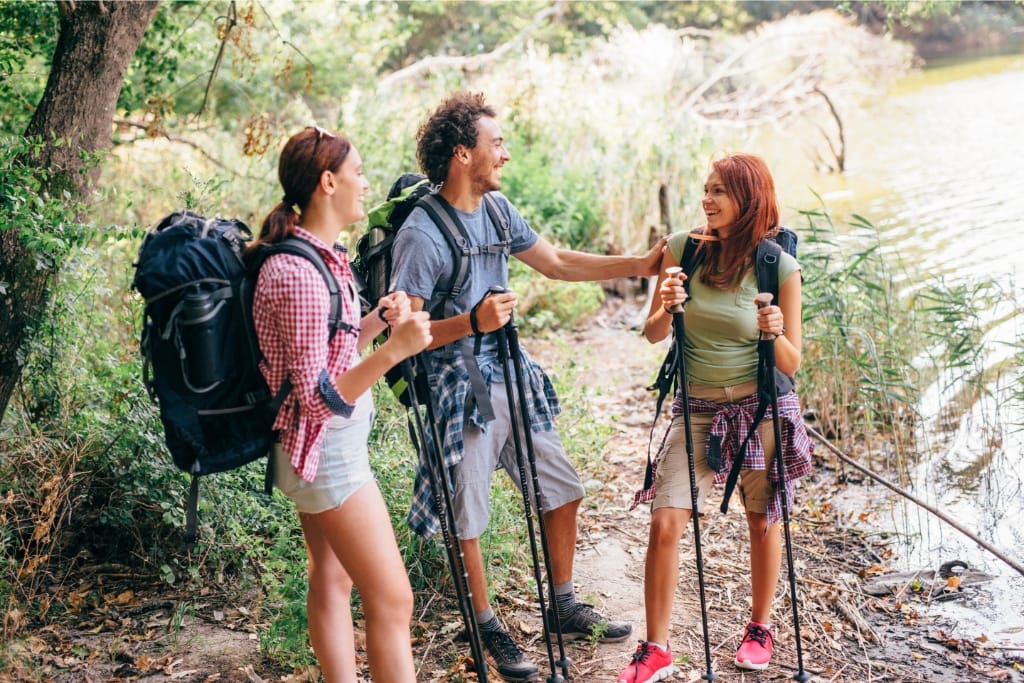10 Steps to Planning the Ultimate Backpacking Trip
Backpacking is more than just hiking with a big bag—it’s about freedom, adventure, and discovering the outdoors in the most authentic way possible.
If you’ve never gone backpacking before, the idea can feel intimidating.
Where do you start?
How do you know what to pack?
What if you get lost?
These are all valid concerns. But the good news is that with the right planning and preparation, your first backpacking trip can be safe, enjoyable, and unforgettable.
We’ll walk through 10 steps to planning the ultimate backpacking trip. Think of this as your beginner’s blueprint, packed with tips, checklists, and practical advice.
By the end, you’ll feel confident enough to lace up your boots, shoulder your pack, and head out into the wild.
Step 1: Choose the Right Destination
Your destination will make or break your trip. For beginners, it’s best to start with trails that are well-marked, not too remote, and relatively short (one to three nights).
This way, you get the feel of backpacking without biting off more than you can chew.
Tips for Choosing a Destination:
- Research beginner-friendly trails: National parks, state parks, and popular backpacking areas usually have well-maintained paths with established campsites.
- Consider your fitness level: Don’t plan a 50-mile trek if you’re new. Start small.
- Check the weather and season: Summer and early fall are usually great times for beginners. Avoid harsh winters or rainy seasons until you’re more experienced.
- Factor in travel time: Don’t spend more time driving than hiking.
Resource: Sites like AllTrails, REI’s Hiking Project, and local hiking forums are goldmines for finding trail reviews and first-hand advice.
Step 2: Research and Plan Your Route
Once you’ve chosen your destination, dive into the details of your route. Knowing where you’re going—and what to expect along the way—reduces stress and ensures you don’t run into surprises.
What to Research:
- Trail mileage and elevation gain (elevation can be tougher than distance).
- Water sources: Streams, lakes, and springs—so you know when to refill.
- Campsite locations: Most trails have designated areas for overnight camping.
- Permits and regulations: Many popular backpacking trails require permits, so check early.
Pro Tip: Download offline maps on apps like Gaia GPS or AllTrails. Cell service isn’t guaranteed in the backcountry.
Quick Route Planning Checklist:
- Print a physical map
- Mark water sources
- Highlight potential campsites
- Write down emergency exit points
Step 3: Check Regulations and Permits
Nothing kills the excitement of a trip like showing up unprepared with the wrong paperwork—or worse, getting fined.
Many trails have specific rules to protect the environment and manage foot traffic.
What to Look For:
- Backcountry permits: Required in places like Yosemite, Grand Canyon, and Glacier National Park.
- Campfire restrictions: Some areas ban fires during dry seasons.
- Bear canisters: Certain areas (like the Sierra Nevada) require them for food storage.
- Group size limits: Some trails cap how many people can camp together.
Warning: Always double-check park websites before your trip. Rules change based on season and conditions.
Best Practice: Book permits early—some fill up months in advance.
Step 4: Gear Up the Smart Way
Your gear can make your backpacking trip either a dream or a nightmare. While you don’t need to buy top-of-the-line equipment immediately, investing in the essentials is non-negotiable.
Beginner Backpacking Essentials:
- Backpack (40–60L for a weekend trip)
- Tent or shelter (lightweight is best)
- Sleeping bag (rated for expected temps)
- Sleeping pad (comfort + insulation)
- Cooking system (stove, fuel, pot, utensils)
- Navigation tools (map, compass, GPS)
- Headlamp (with extra batteries)
- Water filter or purifier
- Food storage system (bear canister or bag + rope)
Hacks for Beginners:
- Borrow or rent gear before investing in expensive equipment.
- Test gear at home—practice pitching your tent in your backyard.
- Pack light—stick to the essentials and avoid “just in case” extras.
Step 5: Master the Art of Packing
Packing for backpacking is about balance: too much and your trip becomes miserable, too little and you risk safety.
The Golden Rule: Pack Light, Pack Smart.
Packing Tips:
- Distribute weight evenly: Heavy items (food, water, stove) should sit close to your back and center.
- Use stuff sacks to keep items organized.
- Keep frequently used items handy: Snacks, rain jacket, map, and first aid kit should be easy to reach.
- Limit clothing: Two shirts, two pairs of socks, one pair of pants, a warm layer, and rain gear are usually enough.
Checklist for Packing Order:
- Bottom: Sleeping bag + pad
- Middle: Heavy gear (food, cooking system)
- Top: Clothes + lighter items
- Outside: Tent poles, water bottle, trekking poles
Step 6: Plan Your Meals and Water
Backpacking isn’t the time for gourmet cooking, but eating well makes a huge difference in your energy and morale.
Meal Planning Basics:
- Calories matter: You’ll burn 2,500–4,500 calories a day depending on mileage.
- Lightweight food: Choose dehydrated meals, instant oatmeal, energy bars, trail mix, and tortillas.
- Easy prep: Stick to foods that require boiling water or no cooking at all.
Water Planning:
- Research sources: Know where streams and lakes are located.
- Carry a filter: Sawyer Squeeze, Katadyn BeFree, or a pump filter.
- Backup purification: Always bring purification tablets as a backup.
Example Daily Food Plan:
- Breakfast: Instant oatmeal + dried fruit
- Snack: Trail mix + jerky
- Lunch: Tortilla + peanut butter + honey
- Dinner: Dehydrated meal (like chili or pasta)
- Dessert: Chocolate bar
Step 7: Train Physically Before the Trip
Backpacking isn’t just walking—it’s walking with weight on your back, sometimes uphill, for hours. Training ahead of time makes your trip way more enjoyable.
Training Ideas:
- Practice hikes: Do local trails with your backpack loaded (start light, build up).
- Stair climbing: Simulates elevation gain.
- Leg workouts: Squats, lunges, step-ups.
- Cardio: Jogging, biking, or brisk walking to build stamina.
Hack: Break in your boots on training hikes. Blisters are the number one trip-ruiner for beginners.
Step 8: Learn Basic Safety and Navigation
Nature is beautiful, but it’s also unpredictable. A little safety knowledge goes a long way.
Safety Basics:
- Tell someone your plan: Share your route and expected return time with a friend.
- Stay on marked trails: Wandering off is how people get lost.
- Check weather forecasts: Avoid storms, floods, or extreme heat.
- Wildlife awareness: Know what animals live in the area (bears, snakes, etc.) and how to respond.
Navigation Tools:
- Map + compass: Learn the basics of using both.
- GPS apps: Handy, but don’t rely solely on technology.
- Landmarks: Use rivers, peaks, and ridges to orient yourself.
Warning: Don’t assume you’ll have cell service—plan as if you won’t.
Step 9: Practice Leave No Trace Principles
Backpacking isn’t just about enjoying the outdoors—it’s about preserving it for future generations. Leave No Trace (LNT) is the gold standard for responsible adventuring.
The 7 Principles of LNT:
- Plan and prepare
- Travel and camp on durable surfaces
- Dispose of waste properly
- Leave what you find
- Minimize campfire impact
- Respect wildlife
- Be considerate of other visitors
Practical Example: Pack out all trash—even food scraps like apple cores. Animals don’t need our leftovers.
Best Practice: Carry a small ziplock bag for trash and a trowel for bathroom breaks.
Step 10: Start Small and Build Experience
Your first backpacking trip doesn’t need to be epic. In fact, starting small is the best way to ensure you actually enjoy yourself.
Beginner-Friendly Trip Ideas:
- One-night trips close to home.
- Flat or low-elevation trails with easy terrain.
- Group trips with more experienced hikers.
Long-Term Growth:
- Each trip teaches you something new—what to pack, what to leave behind, how much food you eat, etc.
- Keep a backpacking journal to record mileage, campsites, meals, and lessons learned.
Motivation Hack: Celebrate your first trip, no matter how short. You’ve done something most people never will.
Conclusion
Planning the ultimate backpacking trip doesn’t have to be overwhelming. Sure, there are lots of moving parts—gear, food, routes, safety, and logistics—but when you break it down step by step, it all becomes manageable.
Think of this process as part of the adventure itself. The preparation you do now sets the stage for the memories you’ll make on the trail.
As a beginner, remember that your first trip doesn’t need to be extreme. A simple overnight hike or a weekend loop can be just as rewarding as a long expedition.
What matters most is that you’re getting outside, challenging yourself, and learning along the way.
With every mile you hike, you’ll grow more confident, and before long, you’ll be ready to take on bigger and bolder journeys.
The beauty of backpacking is that it’s more than just hiking—it’s freedom, simplicity, and connection with nature at its purest.
It teaches patience, resilience, and appreciation for the little things: the sound of wind through trees, a hot meal after a long day, or the stars filling the night sky with no city lights to dim them.
So, take that first step. Use these 10 steps as your blueprint, trust your preparation, and know that the trail will meet you where you are.
Whether you’re venturing out for one night or planning multi-day adventures in the future, the journey begins the moment you commit.
Pack smart, hike safe, leave no trace, and most importantly—enjoy every moment of the adventure.
Download Our Free E-book!







